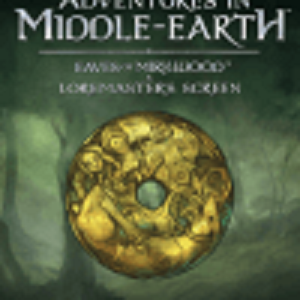
My online group has been giving Cubicle 7’s Adventures in Middle-earth a tryout the last few weekends. The default setting is post-The Hobbit and you only need, per the publisher, Adventures in Middle-earth Players Guide and the D&D 5e Basic Rules (familiarity with 5e mechanics works too, of course). I don’t have any of the game materials–yet!–so I can’t speak to their looks, organization, completeness, etc. This is strictly my first experience as a player–but it won’t be my last because this is a good adaptation.
Our Loremaster (DM) has been running The Eaves of Mirkwood module from the Loremaster’s Screen pack, which takes PCs from Woodmen-town to Lake-town with, this being Middle-earth, all kinds of detours, and engaging–or scary–NPCs, from folk who make Pippin Took look like a newbie-Ranger of the North to an iconic non-Orc monster. Also, the Eaves/Screen pack doesn’t even require the Players Guide, so you can try AiME out for as little as US $10 at Drive-thru RPG. (More on where to buy and current prices below.)
Like many current RPGers, J. R. R. Tolkien and his friend and fellow Inkling C. S. Lewis, introduced me to the fantasy genre, so I have been very happy to play in a LotR RPG that does such a good job of evoking the beloved Middle-earth, and I can’t wait to go back. (Now where did I shelve those novels? This is a house, not Wormtongue’s Chest!) All the group, even our player with the least familiarity with the source materials has been having a great time too. Our Loremaster plays in a tabletop group, too.
Even before we started playing, I was impressed that Cubicle 7 didn’t try to shoehorn LotR character types/tropes and races into the straight 5e classes and races. Even though the novels inspired a lot of these–Rangers, Wizards, Halflings, a good bit of the original Monster Manuals, etc.–I feel they just don’t fit the LotR at all now, and not even in older editions, for the most part. Instead of the familiar Basic Rules/OGL classes, we have Scholar, Slayer, Treasure Hunter, Wanderer, Warden, and Warrior. Also, races are now called Cultures, allowing for Humans to have different stats based on their origins/homeland, similar to the many subraces in the full 5e rules.
The biggest change for many fantasy RPG players, is that there aren’t magic-user classes, which is also one of the things that makes this RPG feel like Middle-earth. Magic in Tolkien’s world is not just quite rare–it’s either relatively minor (enchanted weapons like Sting) or very, very powerful spells/items in the hands of characters far beyond anyone (else) in Thorin’s band or the Fellowship. I have been told there are some minor magic type Virtues (AiME term for Feats) available. This also includes healing and anything that would be covered by cleric/druid spells. So, if you’re really set on a magic-based PC, this probably isn’t your game. It’s not impossible, but very difficult, as my Loremaster attested, having seen the work put into a PC with some limited magical-type abilities, for the tabletop game he’s in.
Another thing that makes AiME feel like a Tolkien novel is the importance placed on The Journey. What happens on the trip is as important–maybe moreso–as the destination and the goal/s. To that end, there is a party Embarkation Roll, to see how easy the Journey will be as well as other rolls at other points in the Journey. (Of course my only natural 1 of the first session was for the Embarkation check.)
There are other AiME specific mechanics that I won’t go into here. Suffice it to say, that as a group familiar with 5e we’ve had no trouble with them. Once in a while, someone will have a quick question like whether a Virtue applies to the current situation, or what a new skill (there are several) is for. Overall, it’s really no different in play from any other D&D 5e game I’ve been in. I highly recommend you try it out the next time your group is looking for a new game–and there’s a lot to be said for not having to learn a completely new set of mechanics when you change settings.
Finally a quick thank you to our Loremaster, Donovan Morningfire. He stepped up to run this mini-campaign on short notice for one thing. Not only that–he’s teaching us the rules, no mean feat, even when your players are familiar with the base version of the rules. I also have no doubt that his GMing talents do even more than the setting-specific mechanics to evoke the Middle-earth feel of the game.
If you like this version of LotR as much as I do, Cubicle 7 offer a Loremaster’s Guide and a number of other regional supplements and adventure books in both print and PDF. Many, if not all of the regional/adventure books do include “material previously released” for The One Ring iteration of the LotR RPG that is “fully converted to be compatible with Adventures in Middle-earth and the OGL rules.” All the line’s books are currently on sale (at the first link above) for US$22.50-40, and include both the physical book and a PDF. Drive-thru RPG also sells the PDFs for $10-20.
I do recommend giving AiME a try. It captures the spirit of the most iconic classic fantasy world, using (mostly) familiar rules, and above all is fun.
Linda Whitson
Latest posts by Linda Whitson (see all)
- Astral Projections – The Ripperdoc Is In - May 8, 2023

I have a special place in my heart for AiME. It’s the only D&D 5e I play, and I think it’s outstanding. The rules feel different than D&D and, as a result, I don’t feel locked into playing a murderhobo. Your article captures the best parts of the game and what makes it an outstanding experience! Thanks for sharing this, Linda! 🙂